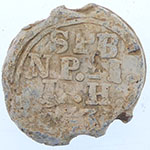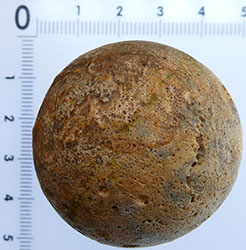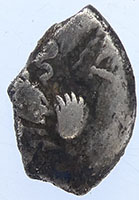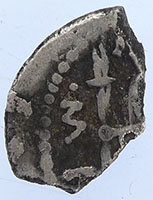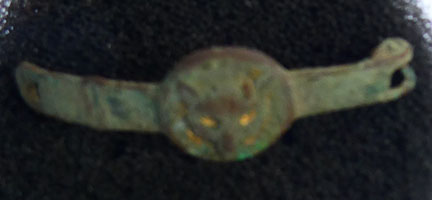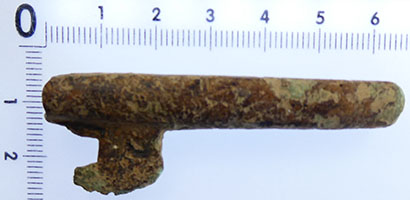

Metal detecting holidays in England with the World's most successful metal detecting club.20 years plus.
Twinned with Midwest Historical Research Society USA.
2022 March Finds page |
45BC Addedomaros Celtic gold stater - reported to museum 4.84G,17.38mm |
|||||||||||
1427-1430 Henry VI hammed silver groat - Rosette mascle issue- mascle and rosette stops Obv +hENRICx DIx GRAx REX ANGL Z FRANC Rev VIL/LAx/CALI/SIE* - Calaise mint |
|||||||||||
11,000 Flint scraper |
|||||||||||
 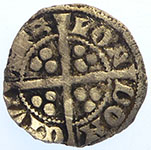 |
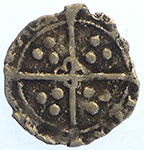 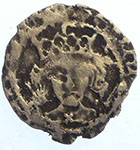 |
||||||||||
1279 Edward 1st Hammered silver penny Obv +EDWAR ANGL DNS hYB Rev CIVI/TAS/LON/DON - London mint |
1422-61 Henry VI hammered silver half penny Satire on neck - quatrefoil in centre of reverse cross |
||||||||||
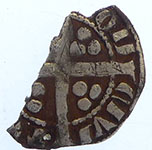 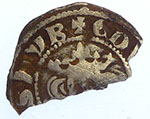 |
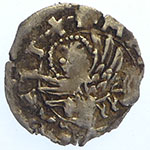 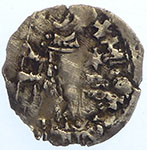 |
||||||||||
1279 Edward 1st Hammered silver penny Obv +EDW *** NS hYB Rev CIVI/TA**** ON - London mint |
Michele Steno 1400-1413 (Type 1) Italian States-Venice, Michele Steno as Doge (1400-1413), Soldino, Venice Mint |
||||||||||
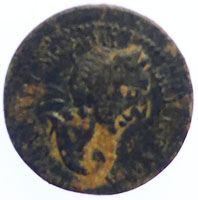 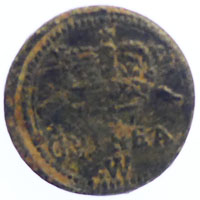 |
  |
||||||||||
| 17th C Gold guinea coin weight - William III | 1634 Charles 1st hammered copper rose farthing | ||||||||||
 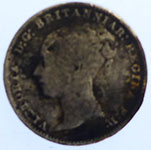 |
 |
||||||||||
| 1865 Victoria milled silver three pence | 1500-1650 buckle | ||||||||||
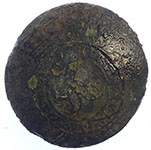 |
 |
 |
|||||||||
| Army button | Georgian watch winder | 2 -18th C crotal bells | |||||||||
  |
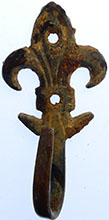 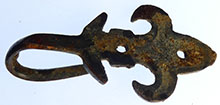 |
||||||||||
| Georgian clasp | Georgian hooked mount | ||||||||||
  |
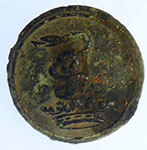 |
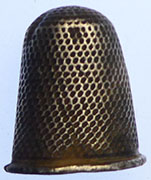 |
|||||||||
| Georgian silver button with glass stone | 19th C livery button | Victorian silver thimble | |||||||||
  |
 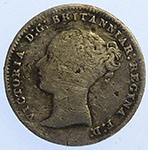 |
||||||||||
1794 Condor token - Middlesex half penny ObverseBust of Hardy to left, name and date below, legend around Lettering: ReverseLegend across six horizontal lines Lettering:
|
1850 Victoria milled silver three pence | ||||||||||
  |
|
||||||||||
| 1838 Victoria milled silver shilling | Very unusual Roman bronze coin - sent off for ID
|
||||||||||
 |
 |
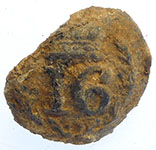 |
|||||||||
| 18th C Toy cannon | 16th C mount | 18th C- 16th Regiment of foot button | |||||||||
 |
 |
 |
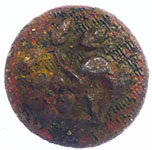 |
||||||||
| 18th C clog fastener | 15th C lead token | UNITED KINGDOM C & D Line Ltd. Commonwealth & Dominion Line In use 1914 - 1937 ? |
Georgian button | ||||||||
 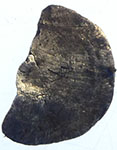 |
 |
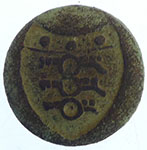 |
|||||||||
| 16th C Elizabeth 1st hammered silver penny | 18thC Royal Artillery button | 18thC Royal Artillery button | |||||||||
  |
 |
 |
|||||||||
| 1845 Victoria milled silver six pence | Georgian spur buckle | Georgian lead spinning top | |||||||||
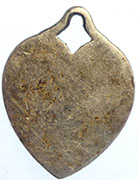  |
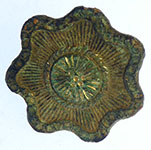 |
 |
|||||||||
| Unmarked silver pendant | Georgian mount | 1500-1700 mount | |||||||||
 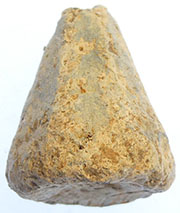 |
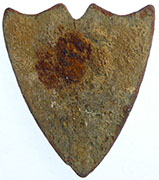 |
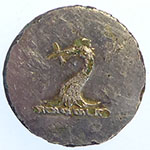 |
|||||||||
| Post medieval lead hanging prism weight | 1500-1700 shield mount | 19th C livery button | |||||||||
19thC decorated musket fitting |
|||||||||||
  |
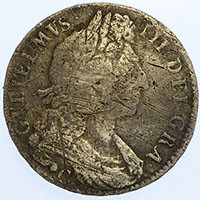 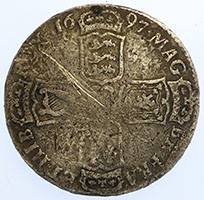 |
||||||||||
1697 William III milled silver half crown (30 pence) Exeter mint |
1697 William III milled silver half crown (30 pence) Coventry mint |
||||||||||
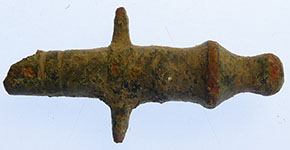 |
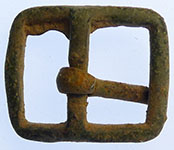 |
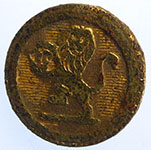 |
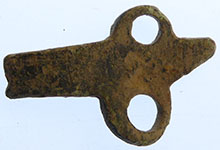 |
||||||||
| 18th C toy cannon | Georgian buckle | MN - G & J Burns Ltd In use 1842 - 1922 | Medieval spur fragment | ||||||||
 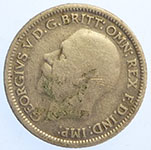 |
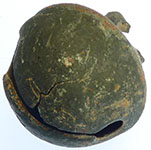 |
||||||||||
| 1929 George V milled silver sixpence | 18th C crotal bell | ||||||||||
17th C seal matrix - griffin facing right impression |
|||||||||||
Fossil |
|||||||||||
  |
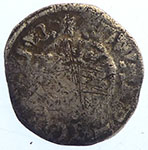  |
||||||||||
| 1815 Russian lead bale seal | 1327 Edward III florin hammered silver penny Obv +EDWAR R ANGL DNS hYB Rev CIVI/TAS/DVR/ELM - Durham mint |
||||||||||
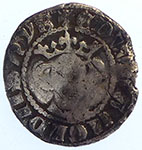 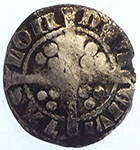 |
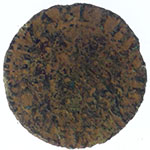 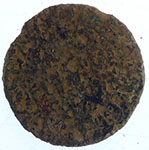 |
||||||||||
1299-1300 Edward 1st Hammered silver penny - Class 9b, pot hook N Obv +EDWR ANGL DNS hYB Rev CIVI/TAS/LON/DON - London mint |
17th C hammered copper trade farthing | ||||||||||
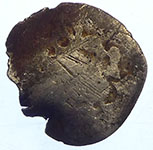 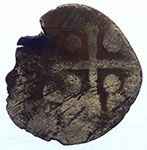 |
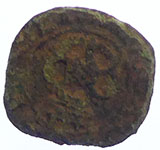  |
||||||||||
| Medieval hammered silver penny- probably Irish by the striking | 1634 Charles 1st hammered copper rose farthing | ||||||||||
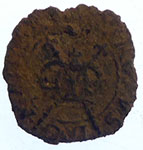 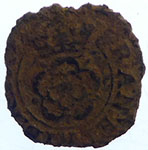 |
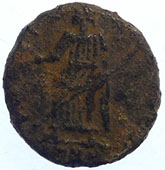 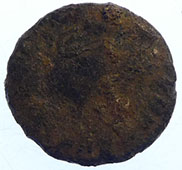 |
||||||||||
| 1634 Charles 1st hammered copper rose farthing | 4thC Roman bronze coin | ||||||||||
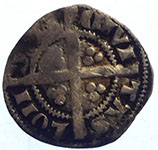  |
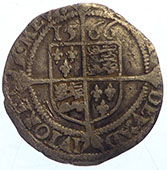 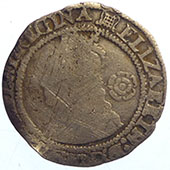 |
||||||||||
1351 Edward III hammered silver penny - pre treaty Obv +EDWARDVS REX ANGL' Rev CIVI/TAS/LON/DON - London mint
|
1566 Elizabeth 1st hammered silver three pence | ||||||||||
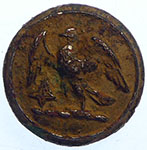 |
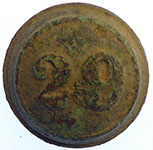 |
 |
|||||||||
| 19th C livery button | 29th Regiment of foot - German ? | 18th C crotal bell | |||||||||
 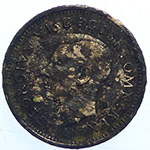 |
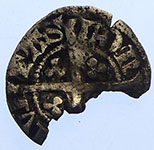  |
||||||||||
| 1940 George VI milled silver three pence | 1314 Edward 1st hammered silver half penny -type 12 Obv +EDWARDVS REX Rev CIVI/TAS/LON/*** - London mint |
||||||||||
 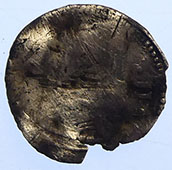 |
|||||||||||
| 1649 Commonwealth hammered silver half groat | |||||||||||
Roman 'animal faced 'socketed bronze fork - multiple holes in socket for rivets to attach wood handle |
|||||||||||
 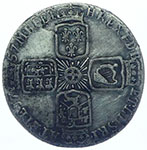 |
  |
||||||||||
| 1757 George II milled silver sixpence | 1247 Henry III hammered silver voided long cross half penny | ||||||||||
1853 Victoria milled gold half sovereign |
|||||||||||
Coenwulf 796 AD King of Mercia hammered silver penny 0.836g, 18.5 mm This is Coenwulf of Mercia, moneyer Lul. Better images and more information would certainly be very welcome. Sent to EMC for recording Thanks for these new images and the weight of the find, which I have recorded as EMC 2022.0104.
|
|||||||||||
 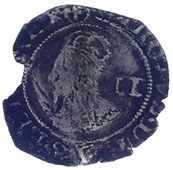 |
  |
||||||||||
| 1625 Charles 1st hammered silver half groat | 1641-3 Charles 1st hammered silver penny - mintmark 2 dots 'triangle and circle' King had left London and Parliament stuck these coins |
||||||||||
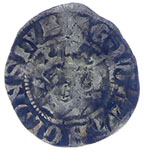 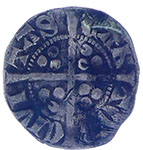 |
 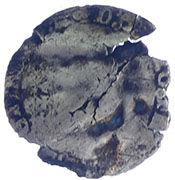 |
||||||||||
1279 Edward 1st hammered silver penny Obv + EDWAR ANGL DNS hYB Rev CIVI/TAS/CAN/TOR - Canterbury mint |
1554 Mary hammered silver groat | ||||||||||
Very interesting silver chain - sent to the museum for their views as it looks early construction |
|||||||||||
 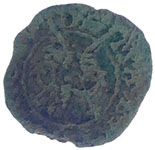 |
  |
||||||||||
| 1634 Charles 1st hammered copper rose farthing | 1554 Mary hammered silver groat | ||||||||||
20th C Gold ring with diamonds ? Marked 375 |
|||||||||||
 |
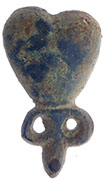 |
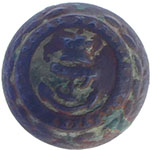 |
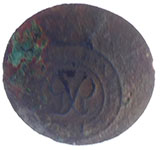 |
||||||||
| French Infantry Button 93rd Line Regiment Circa 1803-1814 |
1500-1700 mount | 1902- 1923 WWI Royal Marines button - Kings crown | Georgian Royal engineers button | ||||||||
 |
 |
 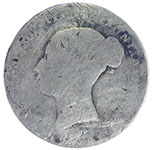 |
|||||||||
| 18thC Royal Artillery button | RN Capt / Commander - 1787 |
1844 Victoria milled silver sixpence | |||||||||
  |
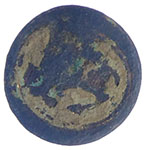 |
 |
|||||||||
| 1856 Victoria milled silver shilling | MN - G & J Burns Ltd In use 1842 - 1922 | 17thC Charles II silver button - reported as treasure to museum | |||||||||
|
|||||||||||
| Very interesting silver jewelry item - need to use sonic cleaner and look for markings | |||||||||||
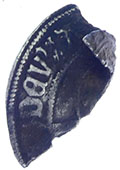  |
 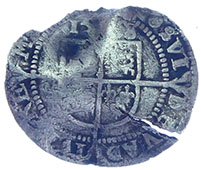 |
||||||||||
| 1509 -26 Henry VIII hammered silver groat | 1568 Elizabeth 1st hammered silver three pence | ||||||||||
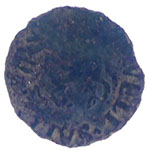  |
 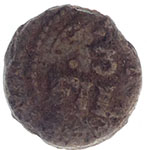 |
||||||||||
| 1656 Samuel Salter of Dedham Essex hammered copper trade farthing | |||||||||||
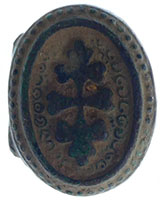   |
 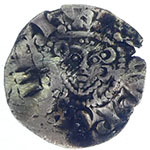 |
||||||||||
| Georgian pill box - not tried to open it yet | 1247 Henry III hammered silver voided long cross penny - Class 5a Obv hENRICVS REX III Rev hEN/RIO/NLV/NDE Moneyer Henri of London mint |
||||||||||
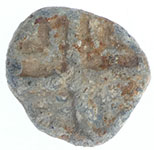 |
 |
 |
 |
||||||||
| 15th C lead token | Trinity House UK Lighthouse Authority Pilot's Tunic Button In use 1900 - 1930s "Trinity House Pilot" |
Description: Crowned 38 over 'Staffs' knot design. Category: Regular Army; Type of button: Convex 16mm; Metal: Copper Alloy, silvered; Backmark: Unreadable; Date: c1800-1820 |
17th C button | ||||||||
 |
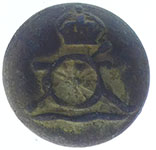 |
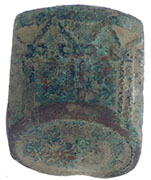  |
|||||||||
| 18th C Royal Artillery button | 1901 - 1952 Royal Artillery button | Early Army drum shaped mount - not certain of regiment yet | |||||||||
  |
 |
||||||||||
| 1834 William IV milled silver sixpence | 19th plate fragment - 4D appears to represent 4 pence 'ihR - 4D' |
||||||||||
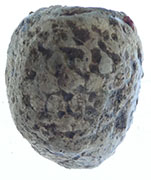 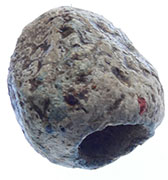 |
 |
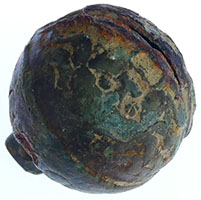 |
|||||||||
| Interesting decorated lead finial | 19th C livery button | 18thC 'fish scale' crotal bell | |||||||||
 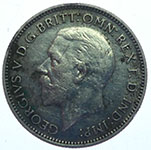 |
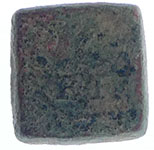 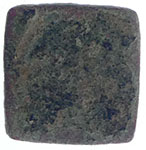 |
||||||||||
| 1935 George V milled silver sixpence | Unknown 17th coin weight - not seen 'RF' on a weight | ||||||||||
1640's Civil war cannon ball 0.96 Lbs - 1 pounder 1.9 inches diameter - 48.5 mm |
|||||||||||
1808 George III milled gold 1/3 guinea 2.81g, 16.99mm |
|||||||||||
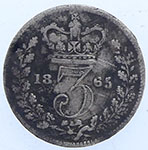 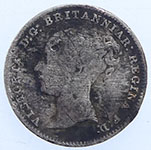 |
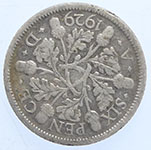 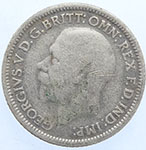 |
||||||||||
| 1865 Victoria milled silver three pence | 1929 George V milled silver sixpence | ||||||||||
 |
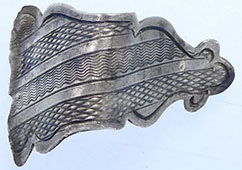 |
 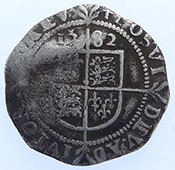 |
|||||||||
Unrecorded 5th Dragoon guards button Description: Crowned Hannover Horse over V D.G with VESTIGIA NULLA RETRORSUM around. Category: Dragoons Type of button: Slightly Convex; Metal: Copper Alloy, silver gilded. Backmark: ; Date: c1780-1796 Crimera war period The 5th Dragoons became Princess Charlotte of Wales's Dragoon Guards in 1804. |
Victorian silver decoration | 1582 Elizabeth 1st hammered silver penny | |||||||||
 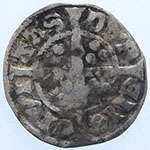 |
|
||||||||||
1291-4 Edward 1st hammered silver penny - Cross moline -Class 6 Obv + EDWAR' ANGL DNS hYB Rev CIVI/TAS/DVR/EME - Durham mint |
Very neat relic - Georgian fob seal with watch winder attached | ||||||||||
  |
  |
||||||||||
Napoleon Bonaparte lead figurine |
2nd C Roman 'head stud' fibular brooch | ||||||||||
 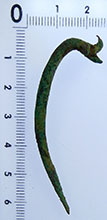 |
 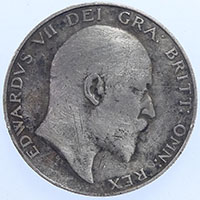 |
||||||||||
| Huge 2nd C Roman fibular brooch | 1902 Edward VII milled silver half crown (30 pence) | ||||||||||
 |
 |
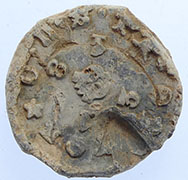 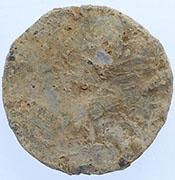 |
|||||||||
Leicestershire Militia 1793-1803
Description: Crown over LM with 2 below Category:English Infantry Militia Type of button: Flat ; Metal: Copper Alloy silvered. Backmark:; Date: c1793-1803 |
Georgian mount | Post medieval lead bale seal | |||||||||
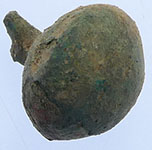 |
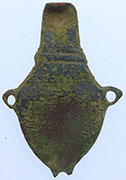 |
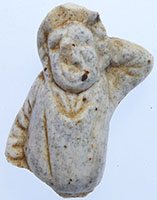  |
|||||||||
| 16th C Tudor buttons | 17th C clothing fastener | Post medieval figurine | |||||||||
 |
 |
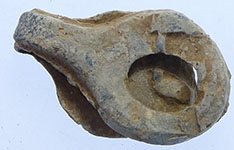 |
|||||||||
W.P Tatham Ardleigh Name is mentioned is 19th C documents as a farmer |
19th C livery button | Post medieval lead cloth seal | |||||||||
 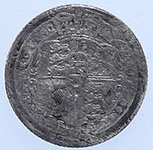 |
 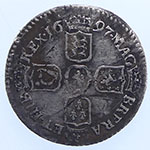 |
||||||||||
| 1818 George III milled silver sixpence | 1697 William III milled silver sixpence | ||||||||||
 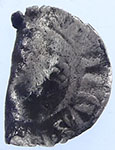 |
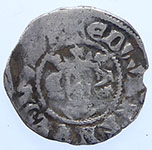 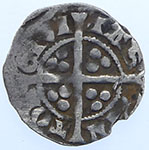 |
||||||||||
| 1216 Henry III hammered silver short cross penny | 1279 Edward 1st hammered silver penny Obv EDWAR ANGL DNS hYB Rev CIVI/TAS/CAN/TOR - Canterbury mint |
||||||||||
Medieval seal ring Used by Edward Saddler |
|||||||||||
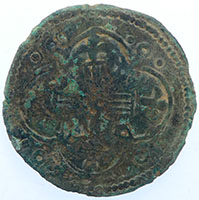  |
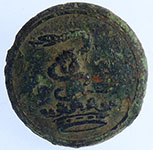 |
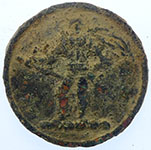 |
|||||||||
| French copper- alloy Jeton 1380 AD Obv Shield of France bearing three fleur de lys | 19th C livery button | 19th C livery button | |||||||||
 |
 |
 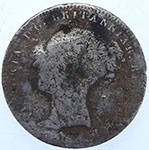 |
|||||||||
| Victorian'Tru Wear' advertising button | Medieval spur rowel | 1849 Victoria milled silver four pence | |||||||||
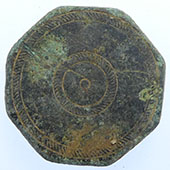 |
 |
 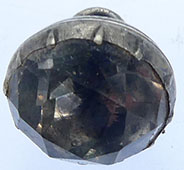 |
|||||||||
| Georgian button | Georgian button | Georgian silver button with glass stone | |||||||||
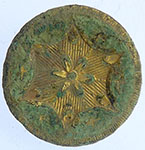 |
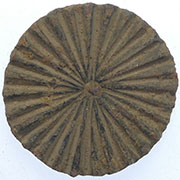 |
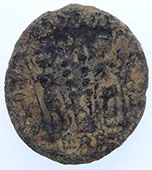 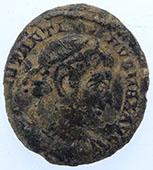 |
|||||||||
| Georgian button | Georgian pastry jigger | 4th C Roman bronze coin sent for ID Constantine I, 307-337 AD Mark |
|||||||||
 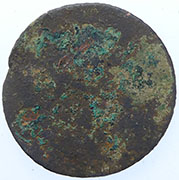 |
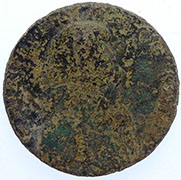 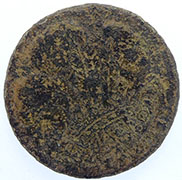 |
||||||||||
1794 Middlesex Prince of Wales Condor halfpenny token Prince of Wales feathers |
|||||||||||
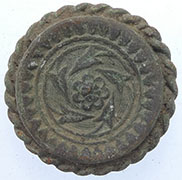 |
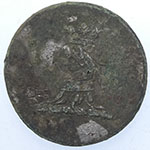 |
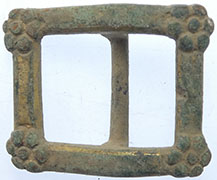  |
|||||||||
| Georgian button | 19th C livery button | Georgian buckle | |||||||||
 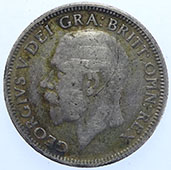 |
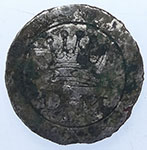 |
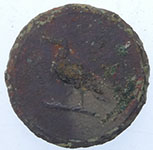 |
|||||||||
| 1927 George V milled silver shilling | Continental Crown Army button 'LM' |
19th C livery button | |||||||||
10-40 AD Cunobelin Celtic silver unit - 0.69g - 13.9mm - sent to CCI for recording Bitch and snake CVN within wreath./Bitch r.,clutching snake in paws,CVN in ex. Classed as Unique in Ref ABC Chris Rudd 32.78 Previous CCI 03.0568 |
|||||||||||
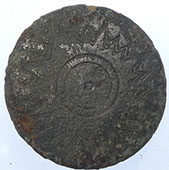 |
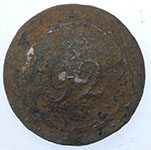 |
 |
 |
||||||||
| Georgian button | THE 92nd REGIMENT OF FOOT Description: 92 within plain inner circle. Category: Regular Army; Type of button: Convex 15mm ; Metal: Copper Alloy silvered; Backmark: EXTRA STRONG PLATED Date: c1820-1840 |
19th C livery button | General Post Office button | ||||||||
 |
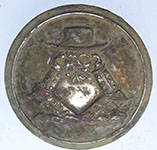 |
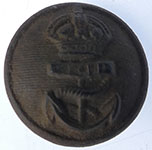 |
 |
||||||||
| 19th C livery button | 19th C livery button | RN Capt / Commander - 1901 Kings crown |
18th C toy cannon | ||||||||
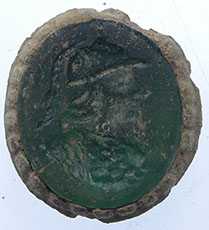  |
 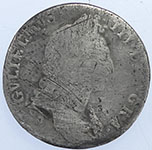 |
||||||||||
| Georgian fob seal | 1695 William III milled silver sixpence | ||||||||||
45BC Addedomaros Celtic gold stater - reported to museum 5.5g, 16.67mm |
|||||||||||
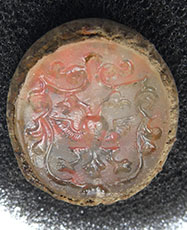   |
|||||||||||
| Georgian fob seal - two eagle head impression | |||||||||||
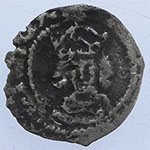 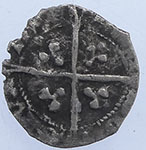 |
  |
||||||||||
| 1485 Henry VII hammered silver halfpenny - single arched crown -Cross furchee | 1816 George III milled silver sixpence | ||||||||||
Great eyeball find - Roman mill stone |
|||||||||||
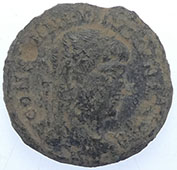  |
 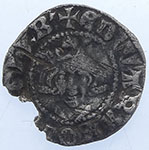 |
||||||||||
4th C Roman bronze - sent for ID Constantine II, Caesar, 317-337 A.D. |
1300-1310 Edward 1st hammered silver penny - Class 10 punctuation after hYB' Obv + EDWAR ANGL DNS hYB' Rev CIVI/TAS/LON/DON - London mint |
||||||||||
  |
 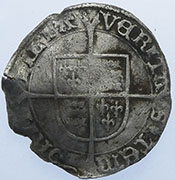 |
||||||||||
| 1247 Henry III hammered silver voided long cross penny | 1554 Mary hammered silver groat | ||||||||||
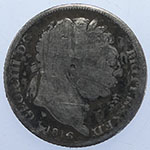 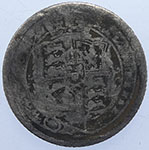 |
 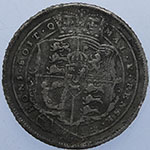 |
||||||||||
| 1816 George III milled silver sixpence | 1819 George III milled silver sixpence | ||||||||||
  |
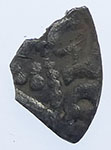  |
||||||||||
| 2nd Roman 'head stud' type fibular brooch | 1247 Henry III hammered silver voided long cross farthing | ||||||||||
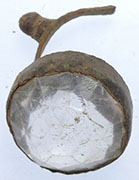 |
 |
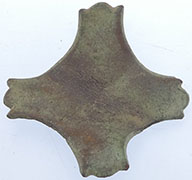 |
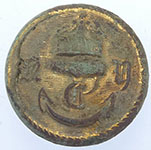 |
||||||||
| Georgian glass cuff link | 1500-1700 hooked mount | 1500-1700 mount | Continental type Crown - Yacht club ? | ||||||||
 |
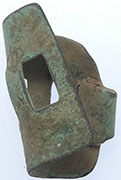 |
  |
|||||||||
| Lead toy horse | 18th C clog fastener | ||||||||||
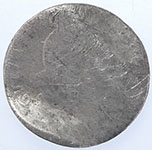 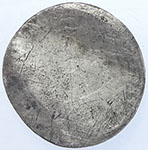 |
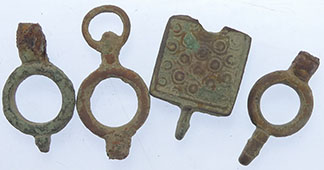 |
||||||||||
| 17th C William III milled silver sixpence - love token | Georgian watch winders | ||||||||||
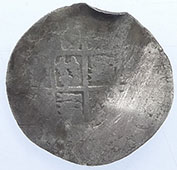 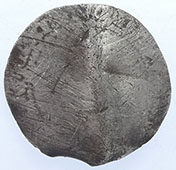 |
  |
||||||||||
| 16th C Elizabeth 1st hammered silver three pence | Great condition 1700 William III milled copper penny | ||||||||||
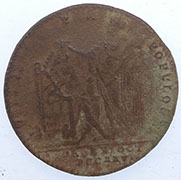 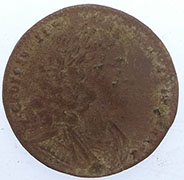 |
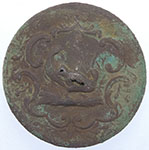 |
 |
|||||||||
| 1714 George 1st official coronation medal by John Crocker. | Georgian button | 19th C livery button | |||||||||
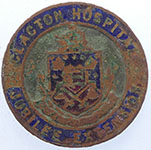 |
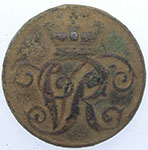 |
  |
|||||||||
| 20th C Clacton Hospital badge | Victoria Royal Engineers button | 1829 George IV milled silver sixpence | |||||||||
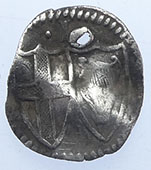 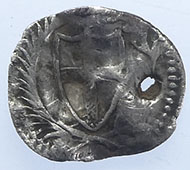 |
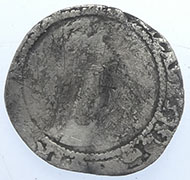 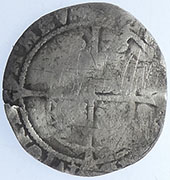 |
||||||||||
| 1649 Commonwealth hammered silver half groat | 1573 Elizabeth hammered silver sixpence | ||||||||||
 |
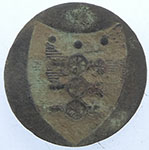 |
 |
 |
||||||||
North York Militia Description: Crowned Yorkshire Rose with 'North' and 'York' either side Category: English Infantry Militia; Type of button: Flat 24mm ; Metal: Pewter Date: c1794-1814 |
18th C Royal Artillery button | Medieval mount | 1900's Generic Merchant Navy Officers |
||||||||
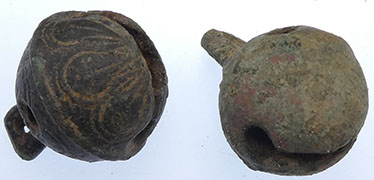 |
 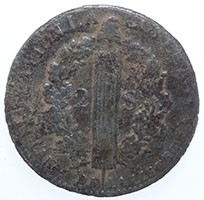 |
||||||||||
| 18th C crotal bells | 1792 Louis XVI French 2 SOLS copper, | ||||||||||
 |
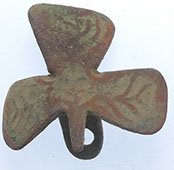 |
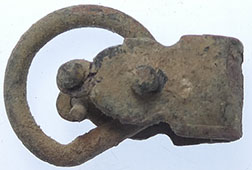 |
|||||||||
John Heath Birmingham mount John Heath established his stationery business in 1852, delivering office products around the Birmingham area and later into other parts of the country. |
20th C mount | Georgian spur buckle | |||||||||
 |
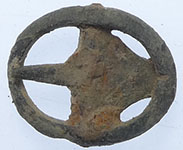 |
  |
|||||||||
| 1500-1650 buckle | Georgian spur buckle | 1817 George III milled silver sixpence | |||||||||
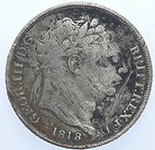 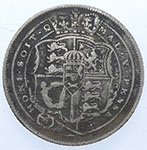 |
 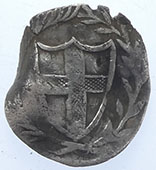 |
||||||||||
| 1818 George III milled silver sixpence | 1649 Commonwealth hammered silver half groat | ||||||||||
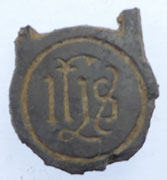 |
 |
 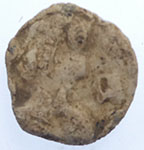 |
|||||||||
16thC Tudor clothing fastener with religious inscription
IHS: dating from the 8th c., this is an abbreviation for "IHESUS," the way Christ's Name was spelled in the Middle Ages (despite popular belief, the monogram stands neither for "Iesus Hominum Salvator" --"Jesus Saviour of Men" -- nor for "In His Service.") Popularized by St. Bernardine of Siena, the monogram was later used by St. Ignatius of Loyola as a symbol for the Jesuit Order. |
15th C lead token - type 3 | 17th C lead token | |||||||||
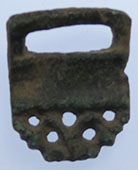 |
 |
 |
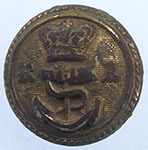 |
||||||||
| 16thC Tudor clothing fastener | 16thC Elizabethan illegal tavern lead token | Royal artillery button
Post 1831 version - three cannons pointing left with the Royal crown over- The design was changed in 1840 with the addition of the 'Ubique' scroll below the lower cannon |
Royal Albert Yacht Club 24.5mm - Pre-1901 Yacht or Boat Club Crown -RA |
||||||||
  |
 |
||||||||||
| 1942 George VI milled silver sixpence | Huge Georgian buckle | ||||||||||
PAS Ref FindID: 638081 |
|||||||||||
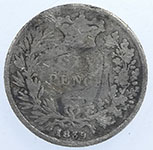  |
  |
||||||||||
| 1839 Victoria milled silver sixpence | 1696 William III milled silver sixpence - Bristol mint | ||||||||||
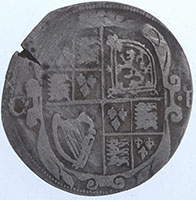 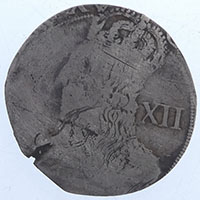 |
  |
||||||||||
| 1625 Charles 1st hammered silver shilling (12 pence) | 1796 Halfpenny Token - Swansea - John Voss Draper | ||||||||||
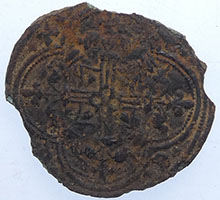 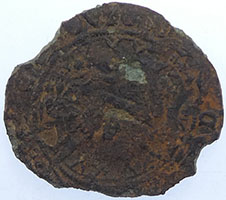 |
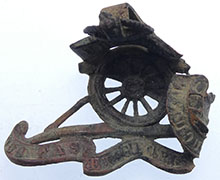 |
||||||||||
| 1380 AD Shield of France jetton | WWII Royal Artillery badge | ||||||||||
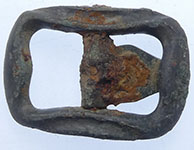 |
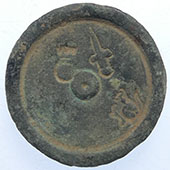 |
||||||||||
| Georgian buckle | 17thC Charles II trade weight - Crown C cipher | ||||||||||
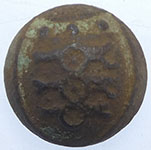 |
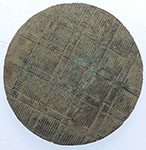 |
|
|||||||||
| 18thC Royal Artillery button | Georgian button | 18th C toy cannon | |||||||||
Unknown Roman widget ?
2nd unknown Roman widget |
|||||||||||
c 800 BC Incredibly rare Bronze Age socketed sickle
Unique ID: BERK-AC4A08 |
|||||||||||
 |
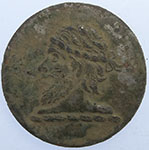 |
  |
|||||||||
| 19th C livery button | 19th C livery button | 1603 James 1st Spur Ryal gold coin weight - 2nd coinage, revalued Crown XVI VI.D |
|||||||||
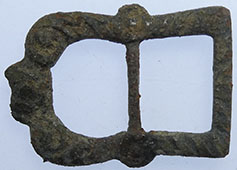 |
 |
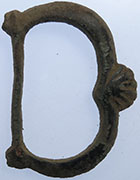 |
|||||||||
| 1500-1650 buckle | Huge 17th C baldric buckle | ||||||||||
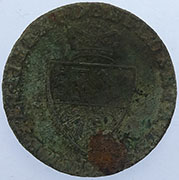 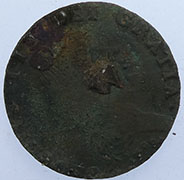 |
  |
||||||||||
| 1791 George III gold spade half guinea gaming piece | 17th C William III milled silver sixpence | ||||||||||
  |
 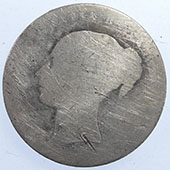 |
||||||||||
| Georgian harness mount | 1858 Victoria milled silver shilling (12 pence) | ||||||||||
Trinovantes British G “Clacton” quarter, Hobbs 192 Celtic gold 1/4 stater 50BC - reported to museum Chris Rudd 23.41 Clacton de Jersey - Classed as scarce 1.053g,13.75mm |
|||||||||||
10-40 AD Cunobelin Celtic gold qtr stater - reported to museum Wild type - Corn ear without cental stork CA to l, MV to r. Horse r, dashes for mane, branch above, CVN below VA2015 Classed as Scarce 1.366g, 10.89mm |
|||||||||||
 |
 |
  |
|||||||||
19th C 'HM' customs button ? Not seen this type before |
18th C Royal Artillery button | Medieval hanger | |||||||||
  |
  |
||||||||||
| Georgian finial | Medieval bronze pot leg | ||||||||||
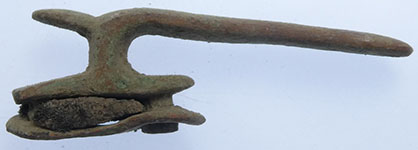  |
|||||||||||
| 18th C bayonet frog | |||||||||||
Posthumous commemorative BI antoninianus for Claudius II, “Gothicus”, 268-270
Typically copper, bronze, potin, or whatever alloy was available – almost never as good “silver” or billon as the originals. This one is better than most unofficial pieces. It is also likely a little smaller than the normal, official issue pieces, too, but I made the photos the same size for comparison’s sake. Ranging through levels of illiteracy many of these have had their legends reduced to abstract, decorative border elements. |
|||||||||||
“PIETAS AVGVSTOR” augur’s Implments
3rd century in this case - |
|||||||||||
BC Roman silver coin - needs cooking to remove 'horn' crust |
|||||||||||
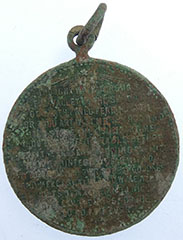 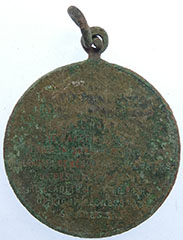 |
  |
||||||||||
Victorian religious medallion Psalm 23:1–6 |
1907 Edward VII milled silver sixpence | ||||||||||
 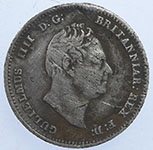 |
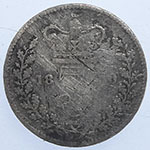 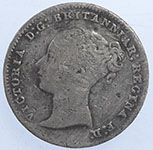 |
||||||||||
| 1837 William IV milled silver four pence | 1850 Victoria milled silver sixpence | ||||||||||
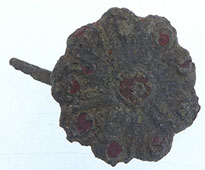 |
  |
||||||||||
| Medieval mount | 1584-6Elizabeth 1st hammered silver half groat - Escallop mint mark | ||||||||||
  |
 |
||||||||||
| 1560-1 Elizabeth 1st hammered silver half groat - Martlet mint mark | Two 18th C toy cannon - little and large | ||||||||||
|
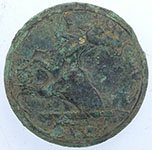 |
 |
|||||||||
| 1634 Charles 1st hammered copper rose farthings | 19th C livery button | 1700's Queen Anne trade weight - Crown A cipher | |||||||||
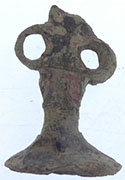 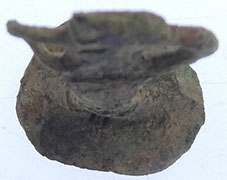  |
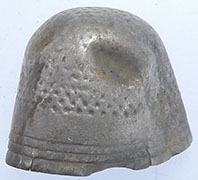 |
||||||||||
| 17th Seal matrix | Victorian silver thimble | ||||||||||
Post medieval Large fox shaped handle |
|||||||||||
 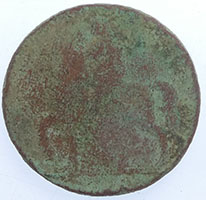 |
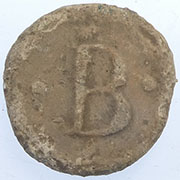 |
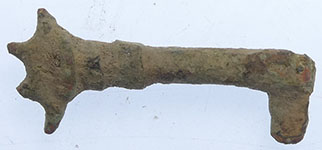 |
|||||||||
| 18th C Condor token - researching it | 17th C lead token | 15th C casket key | |||||||||
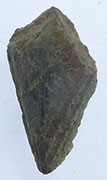 |
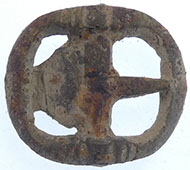 |
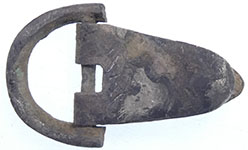  |
|||||||||
| 1500-1700 mount | Georgian spur buckle | Georgian silver spur buckle | |||||||||
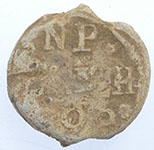  |
|
||||||||||
| Post medieval Russian lead bale seal | Post medieval riveted clasp | ||||||||||
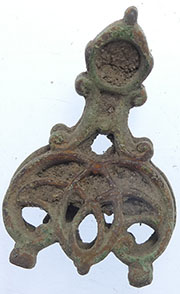 |
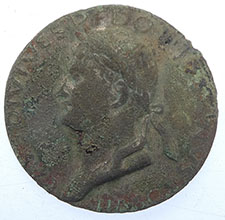 |
 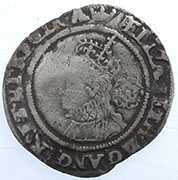 |
|||||||||
| Georgian fob seal hanger | 20th C Medallion 'DIVI ESPEDO 'HASO' |
1569 Elizabeth 1st hammered silver sixpence - Crown mint mark | |||||||||
Medieval dagger pommel 35.8g, 25mm sq x 19.5mm H This late 13th/early 14th-century bronze dagger pommel is of the “crown style” in shape with a central incision for the tang. |
|||||||||||
 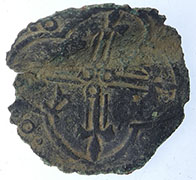 |
 |
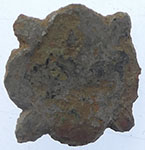 |
|||||||||
| 1380 AD Shield of France jetton | 92nd Regiment of foot button Date: c1820-1840 |
1500-1700 mount | |||||||||
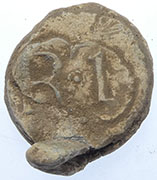 |
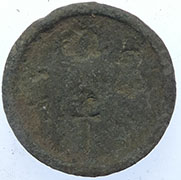 |
||||||||||
| Post medieval lead bale seal | Georgian trade weight - Crown G cipher | ||||||||||
 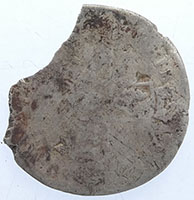 |
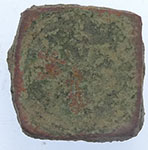  |
||||||||||
1680's James II milled silver shilling JACOBUS II |
Square Sun in shield type coin weight Issued AD 1475 for the French gold ecu as soleil and 1/2 ecu Ecu was worth 4 shillings ( 48 pence in England) |
||||||||||
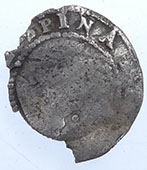 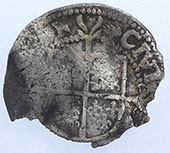 |
  |
||||||||||
| 1590-2 Elizabeth 1st hammered silver half groat - hand mint mark | 1586 Hans Krauwincel II Rose orb Jeton | ||||||||||
|
 |
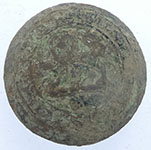 |
|||||||||
| 1770's coin weight - unknown type | Victorian mount | MN - G & J Burns Ltd In use 1842 - 1922 | |||||||||
 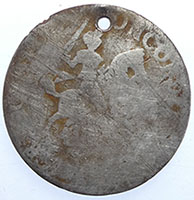 |
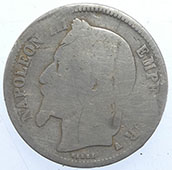 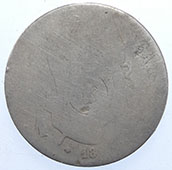 |
||||||||||
Large Continent milled silver coin - researching it 6 Stuivers "Rijderschelling"
ObverseDate above crowned arms (eagle) dividing value Lettering: Translation: Silver money of the city of Deventer ReverseKnight on a striding horse Lettering: Concordia res parvae crescunt Translation:
|
Napoleon III was the first President of France from 1848 to 1852 and the Emperor of the French from 1852 to 1870 2 Franc milled silver coin |
||||||||||
  |
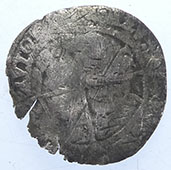  |
||||||||||
| 1851 Victoria milled silver sixpence | 1566 Elizabeth 1st hammered silver three pence | ||||||||||
 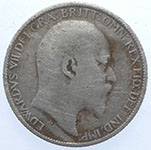 |
  |
||||||||||
| 1906 Edward VII milled silver sixpence | 1921 George V milled silver sixpence | ||||||||||
Looks like a Continental Cockard Sterling imitation penny - researching it
Obv MB ********* Rev BAN/TN/D ************* |
|||||||||||
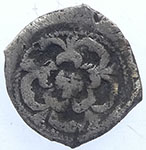 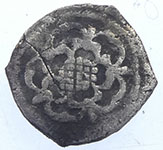 |
 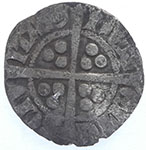 |
||||||||||
| 1625 Charles 1st hammered silver half penny - rose both sides, no legend type | 1279 Edward 1st hammered silver penny Obv + EDWR ANGL DNS hYB Rev CIVI/TAS/DVR/EME - Durham mint |
||||||||||
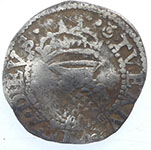  |
 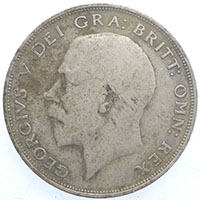 |
||||||||||
| 1605-6 James 1st hammered silver penny | 1921 George V milled silver half crown - 30 pence | ||||||||||
 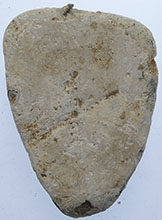 |
|||||||||||
| Rare find c12thC Medieval heraldic shield type lead trade weight - hammer symbol | |||||||||||
 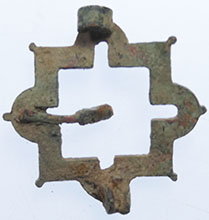 |
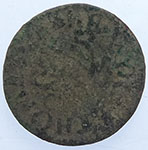 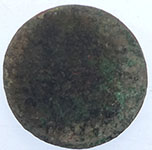 |
||||||||||
| Post medieval enamelled brooch | 17th C hammered copper trade farthing | ||||||||||
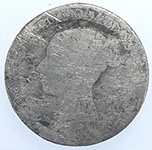  |
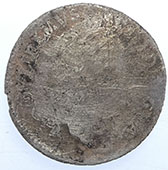  |
||||||||||
| 1839 Victoria milled silver sixpence | 17th C William III milled silver shilling | ||||||||||
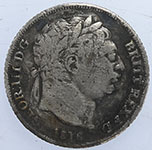 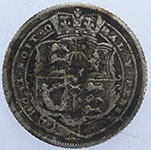 |
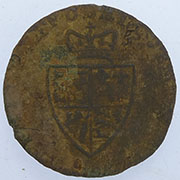  |
||||||||||
| 1816 George III milled silver sixpence | 18thC George III gold half guinea gaming token | ||||||||||
 |
 |
  |
|||||||||
| 1930's Girls Guide badge | 15th C lead token | 2nd C Roman fibular brooch | |||||||||
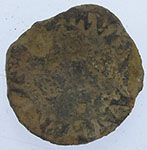 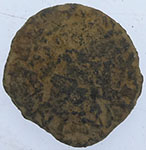 |
  |
||||||||||
| 17th C hammered copper trade farthing | 1667 Isaac Coleman, grocer of Colchester Essex hammered copper trade farthing | ||||||||||
Unknown ancient coin - I am not certain if this is Celtic as I cannot find it in any of my books. It looks similar to a South Western Uninscribed Hobbs 2795 but it is not the right weight or material. Sent for ID 3.44g, 18.66mm |
|||||||||||
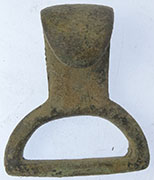 |
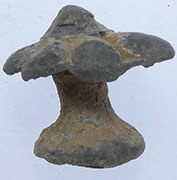 |
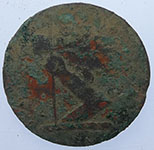 |
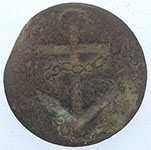 |
||||||||
| Georgian hooked harness buckle | Georgian lead tobacco jar lid handle | 19th C livery button | Capt / Commander - 1774-1787 RN Master & Mate - 1787-1807 RN Surgeon - 1787-1805 RN Purser - 1787-1807 RN Warrant Officer - 1787-1860 RN Midshipman - 1787-1812 RN Volunteer Gr.I - 1787-1812 RN Instructors - 1727-1842 RN Engineer 1st Cl. - 1837-1841 Var. 01 . . . 1774 - 1860 In use 1774 - 1860 |
||||||||
 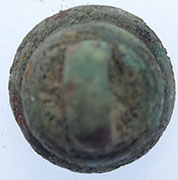 |
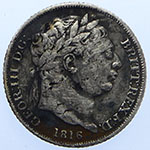 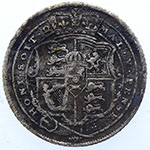 |
||||||||||
| Tiny Georgian bell weight | 1816 Georgian milled silver sixpence | ||||||||||
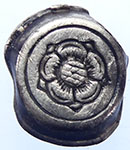 |
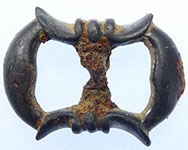 |
|
|||||||||
| 18thC Royal Navy silver button | Georgian buckle | Georgian silver spoon | |||||||||
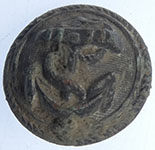 |
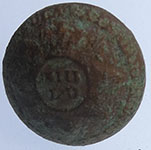 |
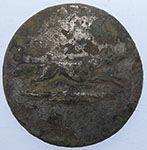 |
 |
||||||||
| 1900's Generic Merchant Navy Officers | Light dragoons button ? | 19th C livery button | 19th C livery button | ||||||||
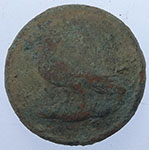 |
 |
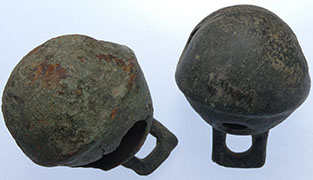 |
|||||||||
| 19th C livery button | Huge Georgian pot foot | 18th C crotal bells | |||||||||
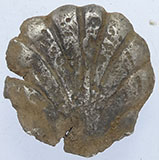 |
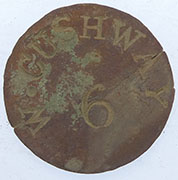 |
|
|||||||||
| Georgian silver shell mount | 'W.Gushway' token | 13th C Continental Sterling copy, hammered silver penny Obv *VDO*** |
|||||||||
  |
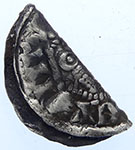 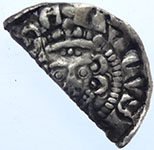 |
||||||||||
| 1926 George V milled sixpence | Taco'd 1247 Henry III hammered silver voided long cross penny | ||||||||||
|
 |
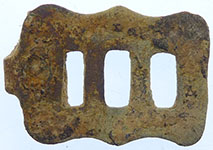 |
|||||||||
| Georgian watch winders | 18th C clog fastener | 18th C clog fastener | |||||||||
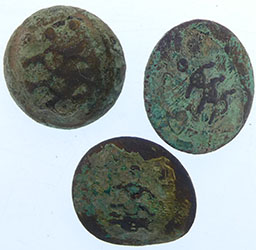 |
|
||||||||||
| 18th C Royal Artillery buttons | 17th lead sewing palm guard | ||||||||||
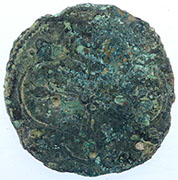 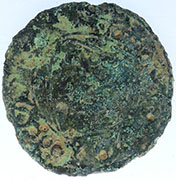 |
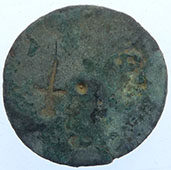  |
||||||||||
| 1380 AD French shield of France 3 lis in a shield type | Medieval trade weight | ||||||||||
 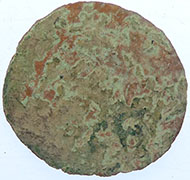 |
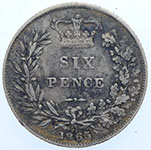 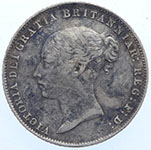 |
||||||||||
| 1586 Hans Krauwincel II Rose orb Jeton | 1865 Victoria milled silver sixpence | ||||||||||
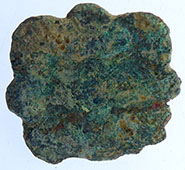 |
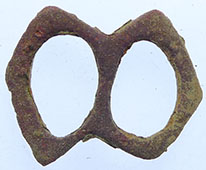 |
  |
|||||||||
| 1500-1700 A copper-alloy cast mount. The mount is quatrefoil in shape with a cusp in each angle. | 1500-1650 buckle | 1875 Victoria milled silver sixpence | |||||||||
Medieval badges Ref Mitchiner p244 939 - 941
|
|||||||||||
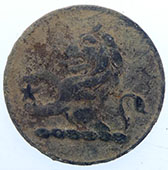 |
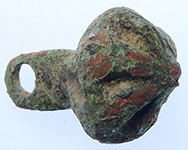 |
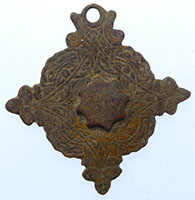 |
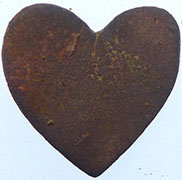 |
||||||||
| 19th C livery button | 16th C Tudor button | Victorian pendant | 1500-1700 mount | ||||||||
 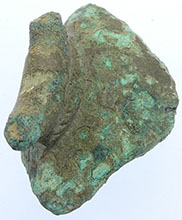 |
|||||||||||
Roman protected loop terret 'Protected loop terrets are usually considered to be Roman and dating to the late first and second centuries AD' |
|||||||||||
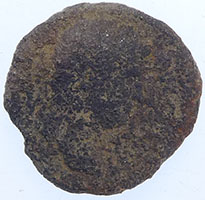  |
 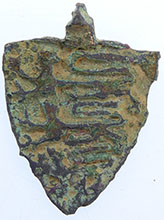 |
||||||||||
| Republican Roman silver coin | c14th C Medieval heraldic shield pendant The shield bears the arms of England before c.1340 (Three Lions) |
||||||||||
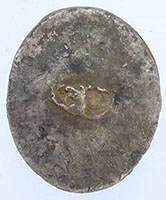  |
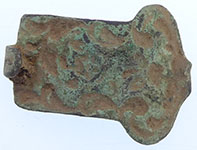 |
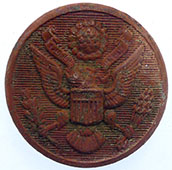 |
|||||||||
| Georgian silver button | 18th C clog fastener | WWII USA GI buttons | |||||||||
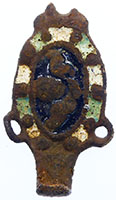 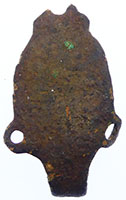 |
 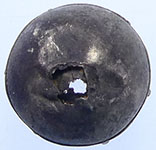 |
||||||||||
| First enamelled 17th C clothing fastener I have seen | Georgian silver button with glass stone | ||||||||||
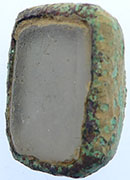 |
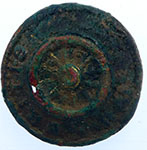 |
 |
 |
||||||||
| Georgian fob seal | 20thC British rail button | Victorian copper pole tip | Post medieval lead trade weight | ||||||||
 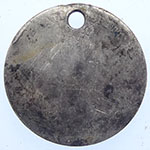 |
1761 Russian St Petersburg lead bale seal |
||||||||||
| 1890 Victoria milled silver three pence | |||||||||||
16th C stone cannon ball |
|||||||||||
 |
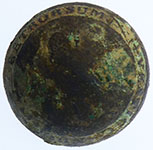 |
 |
|||||||||
| 1900's Generic Merchant Navy Officers | Unknown button 'la bethorsum' ? |
Victorian silver pendant with stone inlay | |||||||||
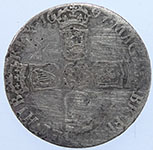  |
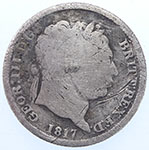 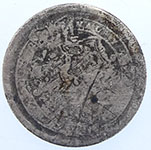 |
||||||||||
| 1697 William III milled silver sixpence | 1817 George III milled silver sixpence | ||||||||||
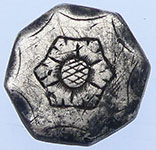 |
 |
 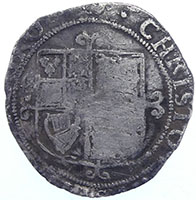 |
|||||||||
| 18th C Royal Navy silver button | Georgian silver thimble | 1639-40 Charles 1st hammered silver shilling (12 pence) | |||||||||
  |
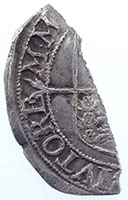 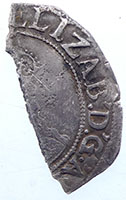 |
||||||||||
1937 Medallion George VI ascended the throne upon the abdication of his brother, Edward VIII, on 11 December 1936, three days before his 41st birthday. Edward's coronation had been planned for 12 May and it was decided to continue with his brother and sister-in-law's coronation on the same date. |
16th C Elizabeth 1st hammered silver shilling | ||||||||||
 |
 |
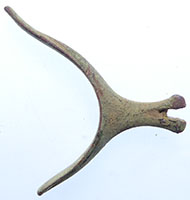 |
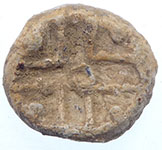 |
||||||||
| RN Capt / Commander - 1812 RN Lieutenant - 1812 RN Midshipman - 1812 RN Volunteer Gr.I - 1812 After this issue a Midshipman will have the Captain's style |
17thC button | Georgian spur | 15th C lead token | ||||||||
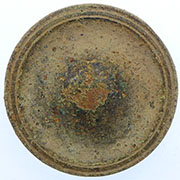 |
 |
 |
 |
||||||||
| 1500-1700 mount | Georgian key | Edwardian brooch | 1808 - 35th Regiment of foot button | ||||||||
 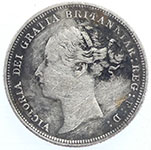 |
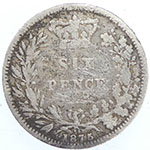  |
||||||||||
| 1883 Victoria milled silver sixpence | 1875 Victoria milled silver sixpence | ||||||||||
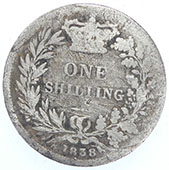 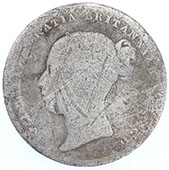 |
 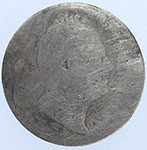 |
||||||||||
| 1838 Victoria milled silver shilling | 1834 William IV milled silver sixpence | ||||||||||
|
 |
||||||||||
Ancient silver coin - researching it
|
Georgian watch winders | ||||||||||
|
|
||||||||||
| Victorian Fox headed clasp | Medieval bronze key | ||||||||||
  |
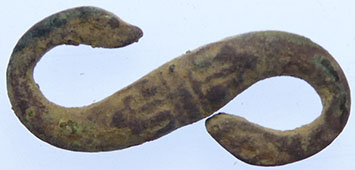 |
||||||||||
| Beauty 14th C seal matrix | |||||||||||
 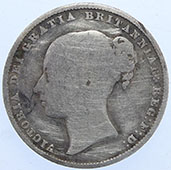 |
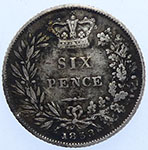  |
||||||||||
| 1864 Victoria milled silver shilling | 1853 Victoria milled silver sixpence | ||||||||||
  |
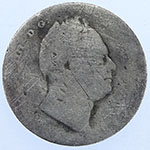 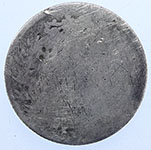 |
||||||||||
| 1727- 60 George II milled silver shilling | 1834 William IV milled silver sixpence | ||||||||||
  |
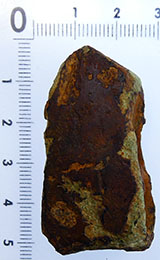 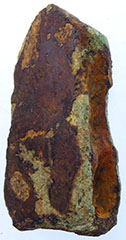 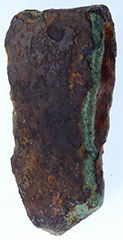 |
||||||||||
| Irish 1461-1470 Edward IV hammered silver penny - D at centre of reverse cross | 850 BC Bronze Age socketed axe head | ||||||||||
April 2022 finds page |
|||||||||||
Sept 2018 Finds pageOct 2018 Finds pageFeb 2019 Finds pageSept 2019 Finds pageOct 2019 Finds pageMarch 2020 Finds page
|
 |

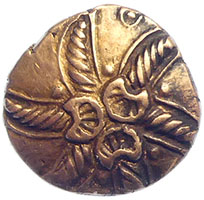
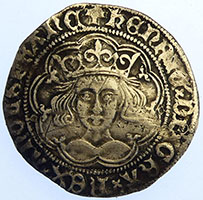

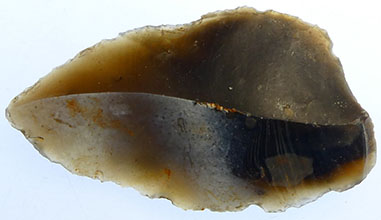
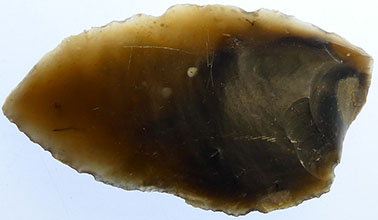
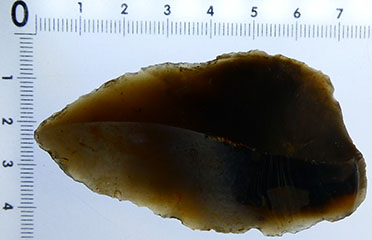
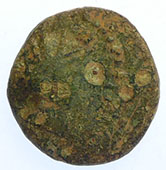
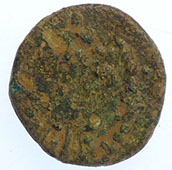
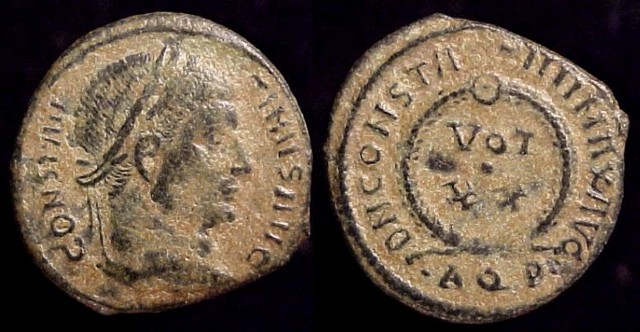
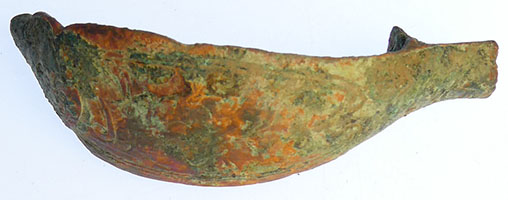












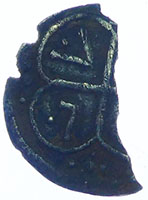
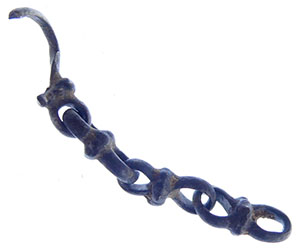
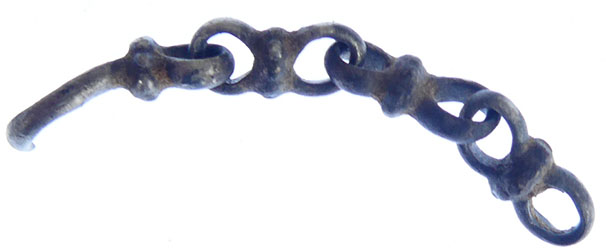


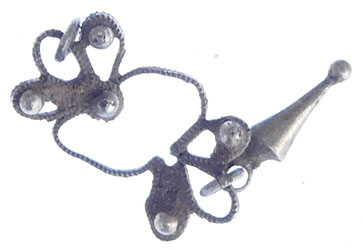
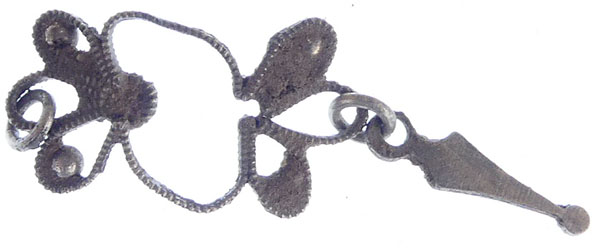
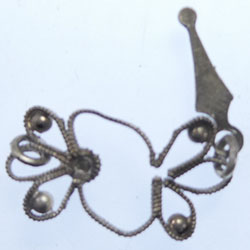
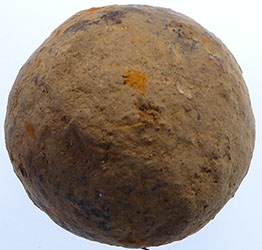
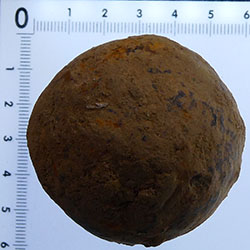
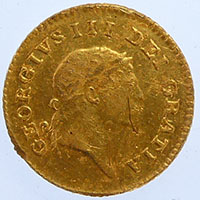

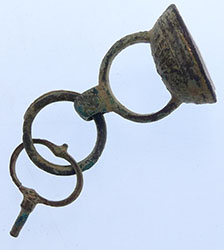
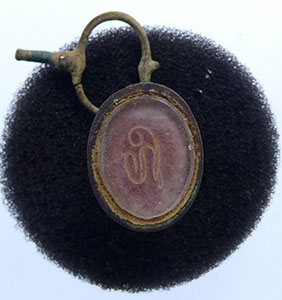
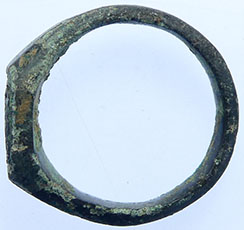
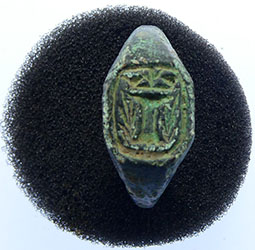
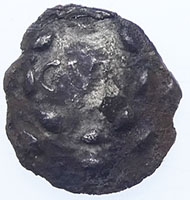
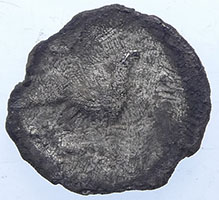

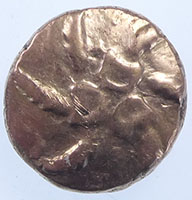
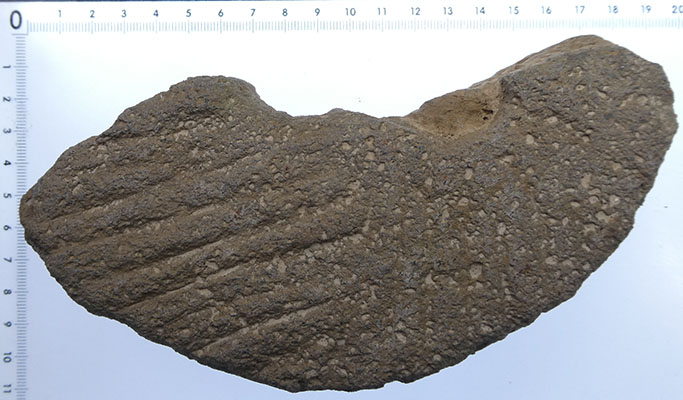






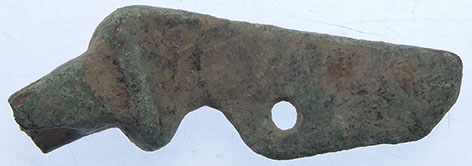

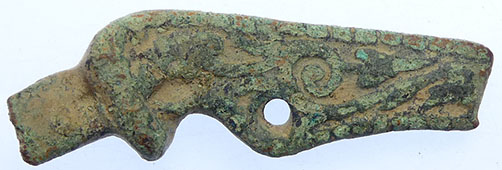



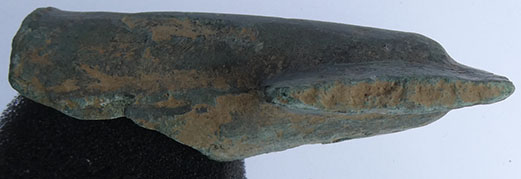


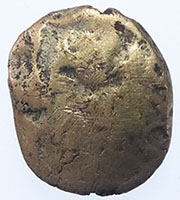
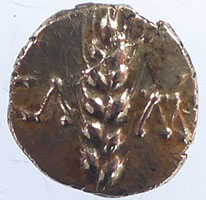


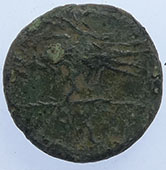

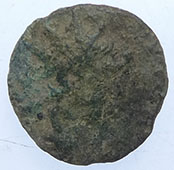
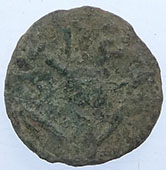

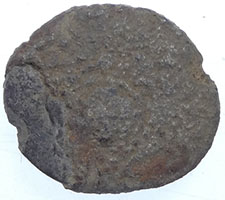
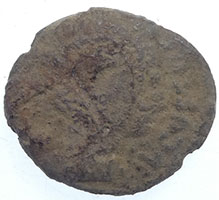

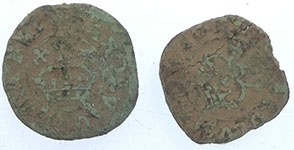
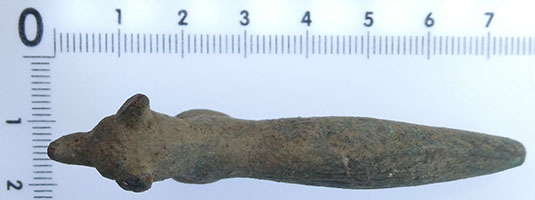
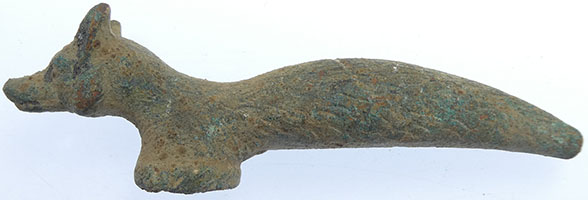


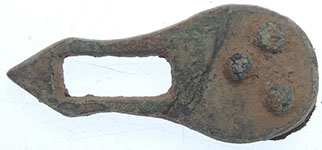



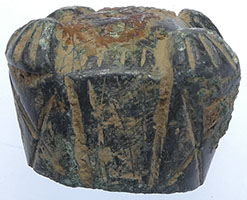
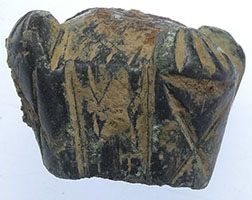
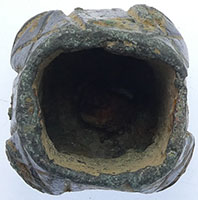

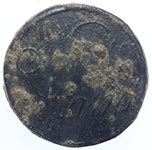
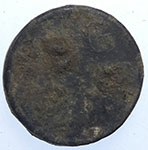
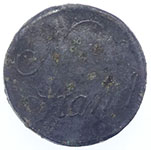
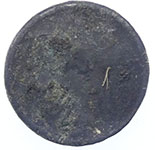
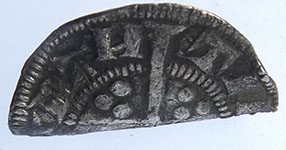


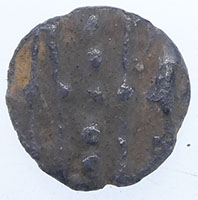

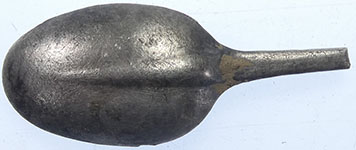
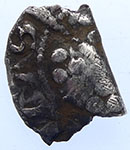

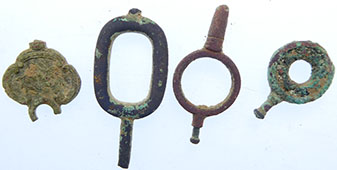




 'A badge for a Knight of the Order of the Holy Sepulchre in bronze and dating somewhere around C13/14th possibly very slightly later . This is a very scarce item and it relates to The Equestrian Order of the Holy Sepulchre of Jerusalem being a Catholic chivalric order of Knighthood that traces its roots to Godfrey of Bouillon, principal leader of the First Crusade. According to reliable sources in the Vatican and Jerusalem, it began in historical reality as a mixed clerical and lay confraternity (association) of pilgrims which gradually grew around the most central of the Christian holy places in the Middle East, the Holy Sepulchre or the tomb of Jesus Christ.This would have been a pin for a member of the order , there is a mark on the reverse where the original pin would have been fixed '
'A badge for a Knight of the Order of the Holy Sepulchre in bronze and dating somewhere around C13/14th possibly very slightly later . This is a very scarce item and it relates to The Equestrian Order of the Holy Sepulchre of Jerusalem being a Catholic chivalric order of Knighthood that traces its roots to Godfrey of Bouillon, principal leader of the First Crusade. According to reliable sources in the Vatican and Jerusalem, it began in historical reality as a mixed clerical and lay confraternity (association) of pilgrims which gradually grew around the most central of the Christian holy places in the Middle East, the Holy Sepulchre or the tomb of Jesus Christ.This would have been a pin for a member of the order , there is a mark on the reverse where the original pin would have been fixed '